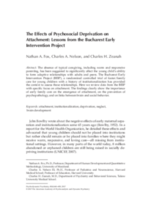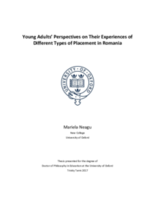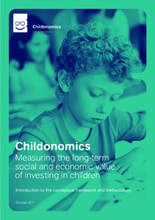Displaying 121 - 130 of 221
This opinion piece by Jana Hainsworth, secretary general of Eurochild and director of the Opening Doors for Europe’s Children campaign, calls on Romania to "use its presidency of the EU Council to champion the move from old-style care institutions to community-based child care and show other EU member states it can be done."
The Bucharest Early Intervention Project (BEIP), a randomized controlled trial of foster/family care for young children with a history of institutionalization has provided the context to assess these relationships. This article reviews data from the BEIP with specific focus on attachment.
This study explores the childhood experiences and transitions to adulthood of 39 Romanian care leavers and adoptees, born around 1989 - 1990.
This study examined facial emotion recognition in 12-year-olds in a longitudinally followed sample of children with and without exposure to early life psychosocial deprivation (institutional care).
The Childonomics project has developed an instrument that can help to reflect on the long-term social and economic return of investing in children and families.
This study examined visual recognition memory and executive functioning (spatial working memory, spatial planning, rule learning, and attention shifting) in 12-year-olds who participated in the Bucharest Early Intervention Project, a randomized controlled trial of foster care for institutionally reared children.
This article utilizes data from the Bucharest Early Intervention Project to examine the neural indices of cognitive control and visual attention biases in children who have been institutionalized in order to understand how they influence the emergence of psychopathology in children with experience in institutional care.
This chapter from Child Maltreatment in Residential Care presents the key findings from the Bucharest Early Intervention Project (2003), a longitudinal randomized control study which revealed the immense developmental impact of the severe deprivation experienced by children placed in institutional care shortly after birth.
This secondary analysis, based off data collected in 1999 by the Survey on Child Abuse in Residential Care Institutions in Romania, investiged the prevalence of growth stunting of institutionalized Romanian children and compared the prevalence of stunting between four different institutional contexts.
This study investigated the correlation between the self-reported academic achievement of Romanian institutionalized children living in long-term residential care and numerous variables related to their experiences in institutional care.



